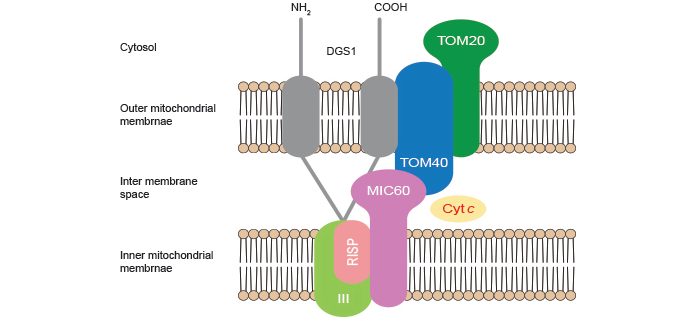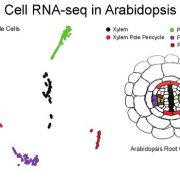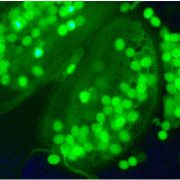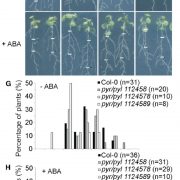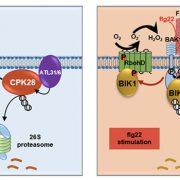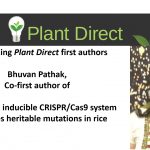The MICOS Complex in Plant Mitochondria
Li et al. reveal a complex regulatory network defining mitochondrial, chloroplast and endoplasmic reticulum function.
Plant Cell https://doi.org/10.1105/tpc.18.00885
By Lu Li1, Anastasiya Lavell2, Xiangxiang Meng1, Oliver Berkowitz1, Jennifer Selinski1, Allison van de Meene3, Chris Carrie4, Christoph Benning2, James Whelan1, Inge De Clercq1, Yan Wang1
1Department of Animal, Plant and Soil Science, School of Life Science, Australian Research Council Centre of Excellence in Plant Energy Biology, La Trobe University, 5 Ring Road, Bundoora, 3086, Victoria, Australia.
2DOE Plant Research Laboratory and Department of Biochemistry and Molecular Biology, Michigan State University, East Lansing, Michigan 48824, USA.
3School of Biosciences, University of Melbourne VIC 3010, Australia.
4Department Biologie I – Botanik, Ludwig-Maximilians-Universität München, Großhadernerstr. 2-4, Planegg-Martinsried, 82152, Germany.
Background: Plant mitochondria consume 50% of the carbon fixed in photosynthesis. In one pathway, the resulting carbohydrates are converted into energy (ATP) to support growth. Another pathway, where the carbohydrates are consumed in an apparently wasteful respiration pathway producing no energy, is called the alternative respiratory pathway. However, this pathway plays an important role in plant stress responses. Previous work had shown that a mutation in an outer membrane protein, called DGS1, resulted in a lower amount of the wasteful pathway, but the role of this outer membrane protein was unknown.
Question: This study investigated the role of the outer membrane protein and its roles in plant growth and stress responses and evaluated how it affected the abundance of the alternative respiratory pathway.
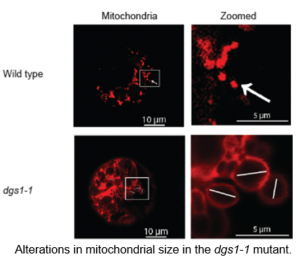 Findings: We found that in Arabidopsis, the mitochondrial outer membrane DGS1 protein was part of a larger protein complex that is involved in building mitochondrial proteins and lipids, also maintaining mitochondrial structure. Mutation of the protein not only affected mitochondrial function and morphology, but also changed the size of chloroplasts, showing the complexity of regulation of lipid homeostasis in plant cells. This resulted in plants that were more stress tolerant, with less abundance of the wasteful alternative respiratory pathway. The results show that there is a complex regulatory network defining mitochondrial, chloroplast and endoplasmic reticulum function and that altering one organelle has profound impacts on the others, at both the morphological and functional levels.
Findings: We found that in Arabidopsis, the mitochondrial outer membrane DGS1 protein was part of a larger protein complex that is involved in building mitochondrial proteins and lipids, also maintaining mitochondrial structure. Mutation of the protein not only affected mitochondrial function and morphology, but also changed the size of chloroplasts, showing the complexity of regulation of lipid homeostasis in plant cells. This resulted in plants that were more stress tolerant, with less abundance of the wasteful alternative respiratory pathway. The results show that there is a complex regulatory network defining mitochondrial, chloroplast and endoplasmic reticulum function and that altering one organelle has profound impacts on the others, at both the morphological and functional levels.
Next steps: The identification of the existence of this multi-subunit protein complex now offers a way to investigate how organelle biogenesis and lipid homeostasis are coordinated between organelles in plant cells.
Featured image: MICOS in Arabidopsis.
Lu Li, Anastasiya Lavell, Xiangxiang Meng, Oliver Berkowitz, Jennifer Selinski, Allison van de Meene, Chris Carrie, Christoph Benning, James Whelan, Inge De Clercq, Yan Wang. (2019). Arabidopsis DGD1 SUPPRESSOR 1 is a Subunit of the Mitochondrial Contact Site and Cristae Organizing System and Affects Mitochondrial Biogenesis. Plant Cell; DOI: https://doi.org/10.1105/tpc.18.00885
Key words: alternative respiratory pathway, Arabidopsis MICOS, lipid homeostasis, mitochondrial biogenesis


